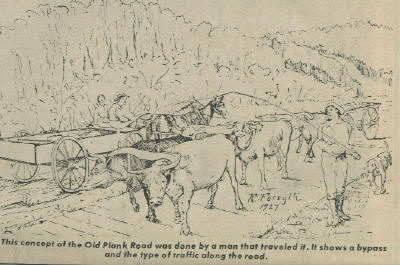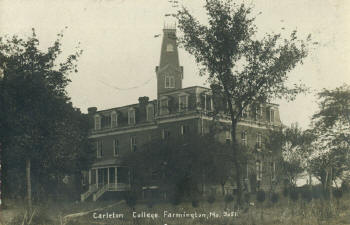TOWN & BUSINESS INDEX PAGE
HOME PAGE
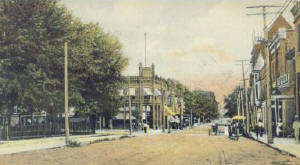 |
EARLY HISTORY OF FARMINGTON
By Marcus Kirkland (1965)
|
I would like to tell you about the early history of Farmington
and its people.
I will take you back
160 years. This part of the country was under
French and Spanish Rule until 1803, when the United States bought it as part of the Louisiana
Purchase. It was known as “Murphy
Settlement.”
In 1798 William
Murphy came over from Tennessee with his three sons, Joseph, William, and David, also with
them, one Silas George. They came by boat to
Ste. Genevieve.
Ste. Genevieve was settled about 1735 by the French.
As there was no one in Ste. Genevieve who could speak English the party came out
about three miles and spent a day or so with a farmer by the name of Madden. They employed an Indian guide, came to the present
location of Farmington and staked four claims. Then
they returned to Tennessee to bring their families.
On the way home the father, William Murphy, and Silas George died, at the home of
John Murphy in Kentucky.
In the Spring of 1800 the three sons, their families, and a younger brother,
Richard returned here to make their homes and to have a great part in the development of Farmington
and this part of the country.
In June, 1802, Sarah Barton Murphy, the widow of William Murphy, her other three
sons, one daughter, a grandson, a hired hand, a Negro woman and a boy came to make their
homes. These three sons were Isaac, Jesse and
Dubert; the daughter, Sarah. This makes seven
sons and one daughter of Mrs. Murphy that came here to live.
There seems to be no
record of what happened between 1803 and 1821 when Missouri was admitted into the Union.
For the residents of Farmington today it is interesting to look back to the city
limits that were established when the city was first laid out. It seems that this David Murphy was a very generous
man as well as one of the outstanding men of his time.
On September 22, 1822, David Murphy deeded to the County Court 52 acres of land to
“fix a County Seat.” This 52 acres
was bounded on the East by Main Street, the street North and South between Robinson Lumber
Company and Detring Mill; on the South by First Street, the one North of the Reliance
Factory; West by “A” Street, the one West of the Old Christian Church; on the
North by Spring Street, the crooked street South of the Laundry and back of the Hotel.
There are 24 blocks in this Survey, 4 North and South, 6 East and West. There were 73 lots in this Survey; they were about
75 feet wide and the entire length of the block, and were numbered from “1” to
“73”. Number “1” was where
the St. Francois Hotel is now.
In this deed Mr. Murphy was to receive back his choice of lots to make up two
acres. He chose for No.1 the lot where the
United Bank’s parking lot and Superior Loan Corp. are, and back to include the
filling station; No.2 was where the furniture store is; No.3 Mells Hardware and part of
filling station all the way back to the other street; No.4 was the lot back of Farmington
News. This made up two acres. Just what the value of these lots are today,
compared to other lots, would be interesting.
The father’s claim was south of our present First Street at the Carter Spring. Carter Spring is in the back yard of M. J.
Antoine’s home. “Hap” tore down
the old spring house and filled the spring when he built his home. But the water still runs out into First Street.
Joseph’s claim was about one and one half miles North of the town. About where Parkview cemetery is located on Old 67
highway. It was then called Potosi Road.
William, Jr. staked his claim about two miles south of town on the place we have
long known as the old Hopkin’s farm. This
was one of the better homes and is on the Copenhagen Road.
David’s claim was where the city of Farmington is located. From First Street North about to the by-pass.
[Note: Click HERE
to view 1880 map of Farmington, Missouri.]
There is some confusion among the old timers as to where Mrs. Murphy lived. But most of them think it was at Jerry’s
because that is the claim of her husband first filed on in 1798. Jerry was the grandson of Mrs. Murphy who came over
here with her in 1802.
County Court
The
first County Court was held at the home of Jerry Murphy in 1821. His home was about where John Whitworth now lives.
The next Court was held at the home of David Murphy; that was the old log house
removed to build the new Washington Elementary school.
This was possibly the oldest house in Farmington.
There is a bronze commerative plaque erected on the grounds of this school, located
at Murphy & Washington Streets, at the original homesite of David Murphy (1769-1843). The lumber from this old house was used in a new
home built in 1950 on Ste. Genevieve Avenue.
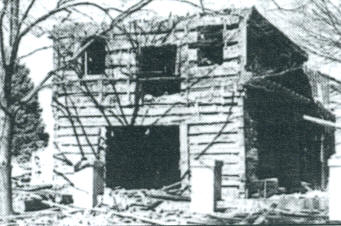
Home of David Murphy, oldest house in Farmington being
torn down.
|
The first Court of Law was also held at this log house, later held at the Church,
until a courthouse was built.
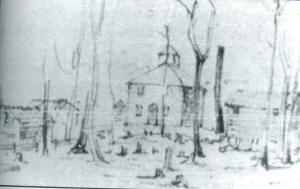
Drawing of First Courthouse
|
The first Courthouse was built in 1826 on the present site which was laid out for it in
the original Survey. There is no picture of
this building, but it was of brick and 30 feet square, two stories high. It was financed and built on the installment’;
that is, when the county had money, work was done. In
1845 a plank fence, 5 feet high, was built around the court square; soon after a hitching
rack was built outside the fence. In 1848 a
two-room, fire-proof house was built on the Southeast corner of the square for storage.
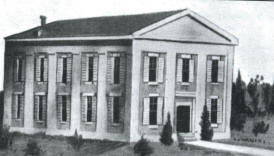
Second Courthouse
|
In 1850 a second Courthouse was built at a cost of $8,000. This must have had eight rooms as they bought eight
stoves. The board fence was still in place. At this time flat rocks were laid as walks across
the streets; they were about two feet apart so they would be used as steps.
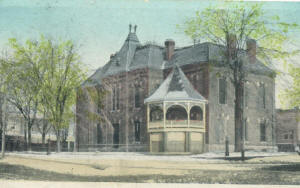
Third Courthouse
|
In 1877 this building was condemned. In
1886 the third Courthouse was finished at a cost of $20,000, and at this time an iron
fence was put around the square. This building
was 38’ x 58’ and was considered large at that time. A sidewalk of flag stones was put around the
square, eight feet wide on the north and south, and six feet on the east and west sides. When the third courthouse was torn down, the iron
fence was removed and part of it was placed at the County Infirmary, now the Mineral Area Osteopathic
Hospital.
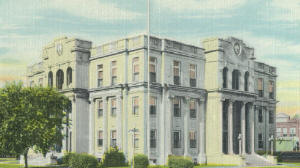
Present Courthouse
|
In May, 1926, the present Courthouse was started, at a cost of $217,172. It was completed in August 1927.
An interesting article in the Court record shows that in 1823 a Stray Pen, 50 feet
square, was constructed for $33.50, where the Christian Church now stands. Due to the lack of fences and stock law in those
days, there must have been considerable need for such a pen.
Jail
The first Jail was erected in 1826 on the site of the present one. It was built of logs, two stories high, with a
dungeon below. In 1850 this building was
burned by a prisoner.
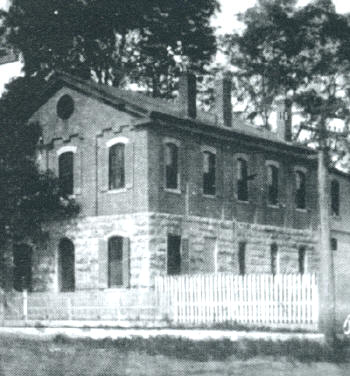
Third County Jail constructed about 1870-1880 at
cost of $11,000.00.
|
In 1855 a second Jail was erected at a cost of $4,000, and about 1880 the present
Jail was erected at a cost of $11,000, which makes this building about 85 years old.
Roads
Kipling said
“transportation is Civilization.”
It seems that
much of the time of the original County Court was spent in laying out roads; to Herculaneum,
Potosi, and West to Pilot Knob. In November,
1822, the road South to Fredericktown was built. These
were all dirt roads.
In 1851 a plank road was started. This
road was the first important road improvement in the State of Missouri. Many top engineers came here from all parts of the United
States to see it. When this road was completed
it was 42 miles long and was a Toll road. The
heavy timbers were placed lengthwise of the road and oak planks, 2 inches thick and 8 feet
long, were placed on these.
This road was only wide enough for one-way traffic, so “Turn-Outs” were
placed at various places. East traffic had the
right-of-way. It took five-days to make the
round trip. Wood bridges were built across the
creeks.
Oxen, mules, and horses pulled the wagons of ore from Pilot Knob and Iron Mountain
to the river at Ste. Genevieve, and on the return trip brought merchandise to Farmington
and on as far as Ironton. The ore was unloaded
at Valley Forge and made into Blooms, or Pig Iron. Valley
Forge was a few miles East on Highway 32, and was quite a village in 1865. Giessing Mill was first there.
This road ran through Farmington on Columbia Street and out on Ste. Genevieve. There was a toll gate at McClard Farm and one near Ozark
Village, and many more. This county did not
abandon this toll road until 1902. It was in
use 51 years.
In 1892 the first rock road in the county was built in Farmington. This was on Potosi Street, from the old Standard
Station to Maple Street. “Believe it or
not,” the first concrete road was built in 1919 at the same place—this was an
experiment—and is 600 feet long and 24 feet wide, and still in use.
Prior to 1856, the year in which the Iron Mountain Railroad was built to Pilot
Knob, Farmington people went by stage coach to Ste. Genevieve and took a boat to St. Louis. After this road was built there was a stage to Iron Mountain.
In 1869 the Belmont Branch was built. It
seems that because a county bond issue of $30,000 was voted down, it was built two miles
West of town.
There were one
or two more attempts to build railroads into Farmington.
In 1912 the Houck Railroad from Cape Girardeau was completed into Farmington. It only operated a few years as it was somewhat of
a joke. About 1917 this was abandoned and J.
Paul Cayce bought it for scrap. There was a
depot out East of town, and the turn-table grade may still be seen at the Aubuchon Home on
the new by-pass.
In 1902 our Electric road was started from Delassus four and one half miles out to
the Power House, at Electric Place. The first
car ran July 24, 1904. The conductor was Guy
Tullock. Also, in 1904 this road was built to
Esther. In 1909 it went broke and was bought
by Wm. Harlan. In 1912 it was sold to the Mississippi
River and Bonne Terre line.
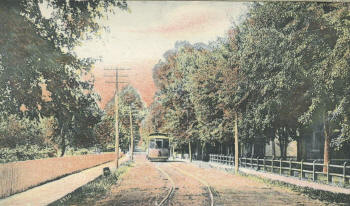
Electric Railroad
|
This was the first electric road in Southeast Missouri.
The first depot was just South of the present laundry.
Miscellaneous Farmington Events
First
child born was Franklin Murphy.
The first Grist
Mill was built by Milton P. Cayce and S. A. Douthit.
The first Hotel
was opened by John Boyce in 1824.
The Masonic
Lodge was started in Nov. 1849 and the I.O.O.F. in October 1850.
The first Bank,
in 1877, was started by A. Parkhurst, with a capitol of $15,000.
The first
Newspaper, in 1860, was called the Missouri Argus. The
Farmington News was started in 1883 by T. P. Pigg. That
makes it about 82 years old.
Nathaniel Cook
was our first County Representative to the State Legislature, in 1822. He lived in Libertyville; it was know then as Cook
Settlement.
Our first Industry was the Tannery of Phillip Long.
It was in the City Park near where the swimming pool is now located. A monument is there about four feet square at the
base and seven feet high; on it are these words “Phillip Long Tannery –
1833.” In the same Park is the Long House
built in 1833. It is in good condition and is
maintained by the Monday Club.
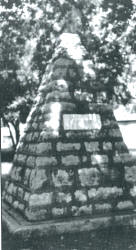
Phillip Long Tannery Monument
|
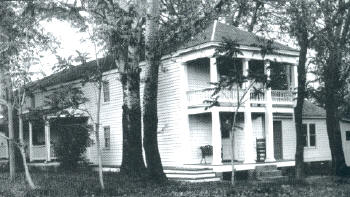
Long House
|
The first Store
was opened in 1823 by John D. Peers on the South side of the square. I wonder where they bought their coffee for 25
years.
I think the
oldest building in Farmington is the spring house at North Washington and Maple Streets,
where Mr. Vandergriff lives. This is the Wade
spring. After David Murphy died, Mrs. Wade
also Mr. And Mrs. Tom Brown lived there. Both
of the ladies were granddaughters of Sarah Barton Murphy.
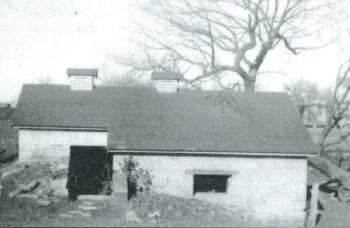
Old Murphy Springhouse at North Washington &
Maple Streets
|
Murphy spring is
on Spring Street in front of the Farmington Body Shop.
It is capped and the water goes under North Washington Street.
Possibly the
next oldest building in Farmington is the two story red brick house, just West of the new
building Roberts built on West Columbia Street. Dr.
Williams lived there. The Williams’ are
buried in the old cemetery north of North Street and just back of the new Christian
Science Church.
Most of the
slaves are buried on the farms where they lived but some of them are buried in the old
Cayce cemetery on West Columbia. Others in the
very old cemetery back of the Odd Fellow Cemetery near the airport. I am quite sure some of you did not know it was
there.
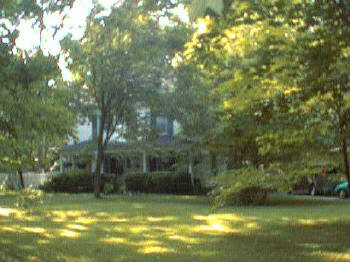
Cayce Home on West Columbia Street, Farmington
|
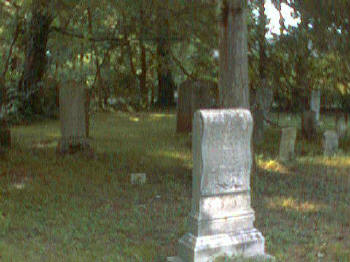
Cayce Cemetery on West Columbia Street,
Farmington
|
Farmington was
incorporated in 1836. 75 votes were cast, 74
for and 1 against.
Alvin Rucker was
the first Mayor, and Charley Hart was the first Sheriff.
The first
automobile was owned by Judge William R. Taylor in 1900.
His home was where the Post Office is now.
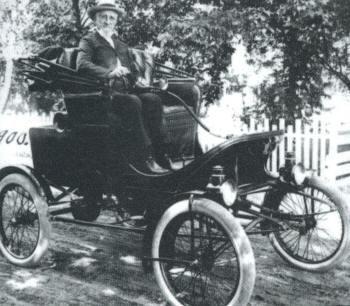
Judge Taylor, Farmington's First Automobile
|
State Hospital
No.4 was opened in 1903.
Did you know we
once had a Cigar Factory here? Sam Pelty, the
father of Gertie, Barney, and Gus, moved his factory from St. Louis.
We had one legal
hanging. On January 23, 1880, Charles H. Hardin was hanged at the South side of the square. Five thousand people were here to see this. Part of the scaffold is still at Robinson Lumber
office.
On June 17, 1843,
James Layton was lynched by a mob just South of the jail.
Richard Murphy was Sheriff at that time.
Although Missouri was not considered a Slave State, this County in 1857 had 806
slaves. Their owners paid taxes on them the
same as animals, from $200 to $900 each.
In 1857 the
total County and State Tax was only $7880; in 1958 it was $2,042,000.00.
Church and School
A great
heritage which the town of Farmington has acquired, began with the arrival of Sarah Barton
Murphy. Through her devout Christian influence
she established a religious atmosphere that survives in this town to the present time. Possibly the first Protestant religious services
ever held West of the Mississippi River was a Thanksgiving Service conducted at her home.
She had a log cabin constructed in which she taught the first Sunday School West of
the Mississippi River in 1805.
Mrs. Murphy
donated an acre of ground for a Church. This
is now part of the Masonic Cemetery. On this
lot a log church, 22 by 30 feet, was built. All
denominations came here to worship. There is a monument about 7 feet high in the Northeast corner of
the cemetery marking the spot where the Church stood.
On this stone are these words: “On this spot the First Sunday School West of
the Mississippi River was organized and taught by Sarah Barton Murphy, in the year 1805,
in the log meeting-house which was the first Protestant Church West of the Mississippi
River,” erected by her great-grandson Hugh Long.
Mrs.
Murphy died in 1817 and was buried where the Masonic Hall is now and later moved to the Masonic
Cemetery. She was here only 15 years.
This community
was, as it is now, always interested in education. As
early as 1803 there was a private school taught by Mrs. Murphy.
In 1821 Township Schools were set up under Missouri law. At that time there were only 4 townships in the
county. In 1833 there was formed a more
complete system, but not until 1870 was the District system set up. There has been little change since.
In 1854 the Carleton Institute was founded by Eliza A. Carleton.
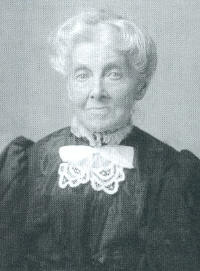
Eliza A. Carleton
|
This log cabin school was located about eight miles north of Farmington, near Big River
Mills. She received for her teaching $3.00 in
trade, and $2.00 in cash from each pupil. In
1859 Carleton College was granted a charter by the State Legislature. In 1876 Mrs. Carleton bought 16 acres of land in Farmington;
as you know, this is on Ste. Genevieve Avenue – and built the first building. Later she built a second one. In 1878 the College opened and for 35 years the
Institution was a vital factor of this community. Dr.
Shuttler was a teacher. Many of our people
attended there. It closed in 1916. The bricks from the old building are now used in
the houses at the old City Disposal Plant. The
second building is now the Catholic School.
Elmwood
Seminary was opened in 1886, for ladies only, in the old building of the Presbyterian
Home. This school was a revival of one started
in 1840 by M. P. Cayce. (The Presbyterian Home
was begun in 1914 on the site of the Elmwood Seminary.)
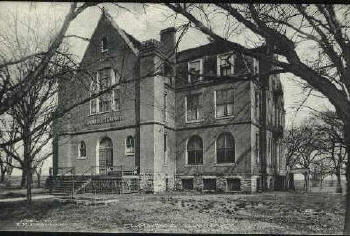
Elmwood Seminary
|
In this same
year the Baptist College was opened. This
building stood where the junior High School is now.
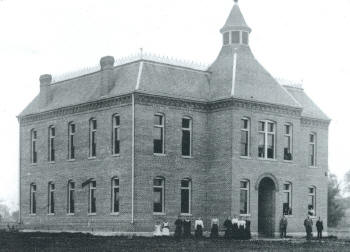
The Baptist College
|
The City School
did not start here until 1870 on the site of South Ward.
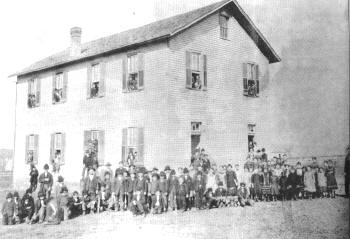
First public school in Farmington, built about
1870
|
The growth of Farmington was slow. In
1860 there were less than 500 people here; in 1890 there were 1350.
Additional history of Farmington
is available in the public library in the Long Memorial Building. Louis Houck and Tom Miles wrote a history, and Pal
Woods compiled a scrapbook of lasting historical information.
Many thanks to Jeanne (Hunt) Nassaney for transcribing this article
for us! This article was originally published by The Farmington News Printing
Company in 1965.
TOWN &
BUSINESS INDEX PAGE
HOME PAGE
This page was updated: Friday, 23-Feb-2024 12:43:00 MST
This site may be freely linked, but not duplicated in any way without consent.
All rights reserved! Commercial use of material within this site is prohibited!
© 2000 - 2024 MOGenWeb
The information on this site is provided free for the purpose of researching your genealogy. This material may be freely used by non-commercial entities, for your own research. The information contained in this site may not be copied to any other site without written "snail-mail" permission. If you wish to have a copy of a donor's material, you must have their permission. All information found on these pages is under copyright of Oklahoma Cemeteries. This is to protect any and all information donated. The original submitter or source of the information will retain their copyright. Unless otherwise stated, any donated material is given to
MOGenWeb to make it available online.


